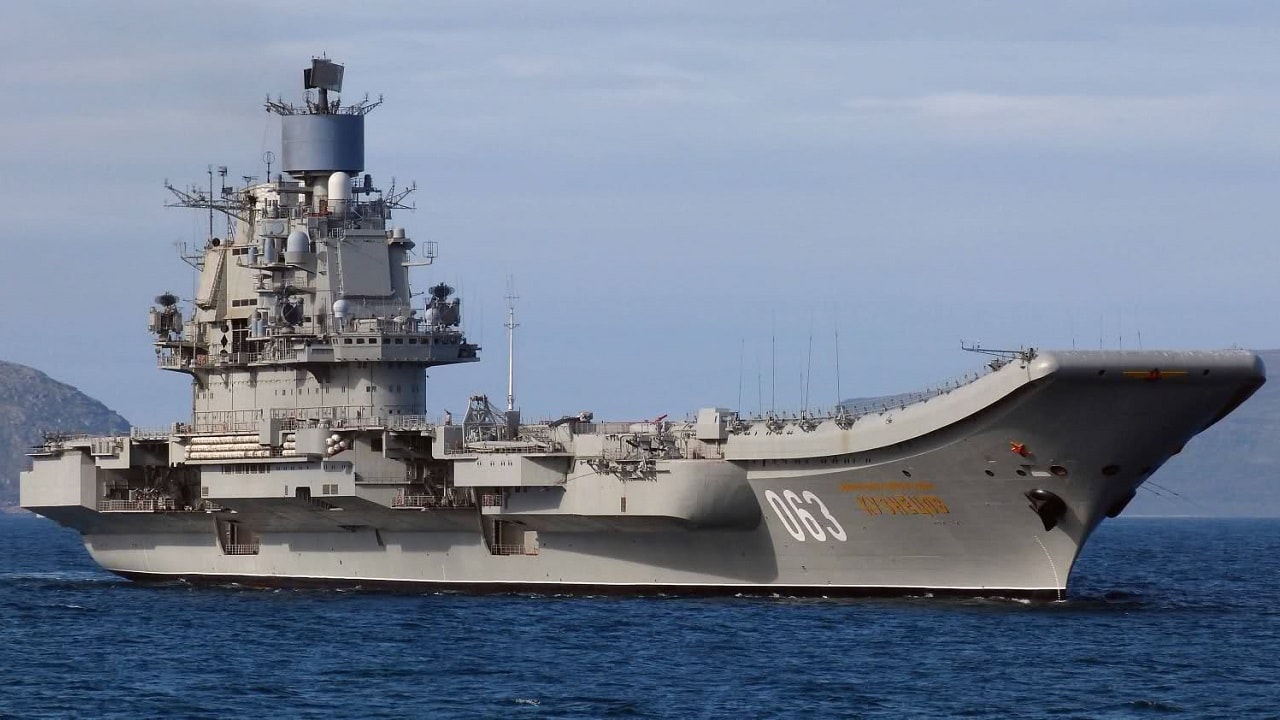Just a Mess: The MiG-29K Fulcrum D, Russia’s carrier-based fighter, exemplifies the failures of Russian naval aviation. Designed for operations from the troubled Admiral Kuznetsov carrier, the MiG-29K has faced obsolescence due to Russia’s lack of a reliable carrier.
-Despite a modern radar, Mach 2 speed, and reasonable weaponry, it has underperformed, with numerous crashes tarnishing its reputation, particularly in India.
-Initially conceived to counter the U.S. F-14 Tomcat, the MiG-29K’s limited deployment and lack of strategic impact, especially in Ukraine, highlight its underwhelming legacy.
-Without a functioning carrier, this aircraft remains a cautionary tale in failed military and naval coordination.
MiG-29K: How Russia’s Aircraft Carrier Fighter Fell From Grace
This airplane is a cautionary tale about failing to execute successful carrier operations. I’m talking about the Russian MiG-29K Fulcrum D fighter lost in the shuffle.
The MiG-29K is designed to take off from aircraft carriers, but the Russian Navy does not have a functioning carrier. Only the cursed Admiral Kuznetsov remains in the fleet, a lemon that is in extended dry dock repairs to fix numerous problems, many of which have led to tragic loss of lives.
Inauspicious Fighter Jet That Has Been Largely Forgotten
It shouldn’t be this way because the MiG-29K is not such a bad bird. It is modernized, having been sent to the naval aviation fleet in 2010. The Fulcrum D has conducted some missions over Ukraine, but it hasn’t exactly set the world on fire.
Not A Menacing Presence
Its weapons configuration is okay and nothing special. There are eight hardpoints for the usual assortment of missiles and bombs, such as anti-ship and anti-radar models, with a capacity of 10,000 pounds for munitions. A 30mm cannon is on board for close-in fighting.
High Speed Is a Salespoint for India
One good thing about the MiG-29K is its speed. It tops out at MACH 2, which is not too shabby with its twin RD-33MK engines. The MiG-29K was not meant for export but it has flown with the Indian Air Force – just not that well.
India Has Struggled with the MiG-29K
A MiG-29 crashed near Barmer, India, on September 3. The pilot had to eject, but the airplane wasn’t damaged badly. This is not the kind of news that places much confidence in the capabilities of MiG-29K. Two other Indian crashes happened in 2019 and 2020.
Admiral Kuznetsov Aircraft Carrier. Image Credit: Creative Commons.
In 2011, a MiG-29KUB trainer of the Indian Navy went down during a test flight in Astrakhan oblast, Russia. The mishap, which happened due to an unskilled pilot, killed both on board. India has 65 MiG-29s.
The MiG-29K has a single pilot. It is nearly 57 feet long and has a wingspan of 39 feet. When loaded, it weighs almost 41,000 pounds.
Many MiG-29Ks Are Collecting Dust
In 2009, the Russian navy ordered 24 MiG-29Ks and MiG-29KUBs. Those airplanes have been forgotten, and besides the ones that have flown over Ukraine, most are likely collecting cobwebs.
A Counter to the Tomcat
The MiG-29K has endured a long development lifecycle. It was first conceived in the 1970s. The Soviet Union tried to keep up with American carrier operations featuring the famous F-14 Tomcat. They needed a powerful, carrier-borne, all-weather, day-night interceptor to protect the fleet from Tomcats that could threaten Soviet warships.
Admiral Kuznetsov. Image Creative Commons.
The MiG-29K was finally ready by 1982 when it took its first flight. It wasn’t until 1989 that it had a successful landing on the unlucky Kuznetsov. Soviet designers tried to devise new ways to make the undercarriage of the MiG-29K strong enough to withstand the wear and tear of carrier operations. Engineers also used the RD-33MK engines on the MiG-29K.
Radar Is a Strong Point
The Fulcrum D does have a pulse doppler radar for better situational awareness. The radar system can track ten targets. Pilots use three LCD screens. There is also an infrared search and track mechanism.
However, despite the disadvantages, this airplane has been disappointing. When there is no carrier available, the purpose is defeated. The Kuznetsov is a total flop and death trap with its myriads of mishaps, including fires and dropped cranes.
Overall, a Cautionary Tale
Thus, the MiG-29K program has to be considered a failure and a reminder that the Russian navy is weak without a carrier. It certainly can fly missions from the ground, but it is not an airplane that Ukraine is worried about.
Perhaps it will receive a new life if the Kuznetsov can ever escape its long re-fit period, but the MiG-29K currently is not a factor in the war in Ukraine, and that is one less jet to worry about for Ukrainian generals.
About the Author
Brent M. Eastwood, PhD, is the author of Don’t Turn Your Back On the World: a Conservative Foreign Policy and Humans, Machines, and Data: Future Trends in Warfare plus two other books. Brent was the founder and CEO of a tech firm that predicted world events using artificial intelligence. He served as a legislative fellow for U.S. Senator Tim Scott and advised the senator on defense and foreign policy issues. He has taught at American University, George Washington University, and George Mason University. Brent is a former U.S. Army Infantry officer. He can be followed on X @BMEastwood.
Now serving as 1945s Defense and National Security Editor, Brent M. Eastwood, PhD, is the author of Humans, Machines, and Data: Future Trends in Warfare. He is an Emerging Threats expert and former U.S. Army Infantry officer.
